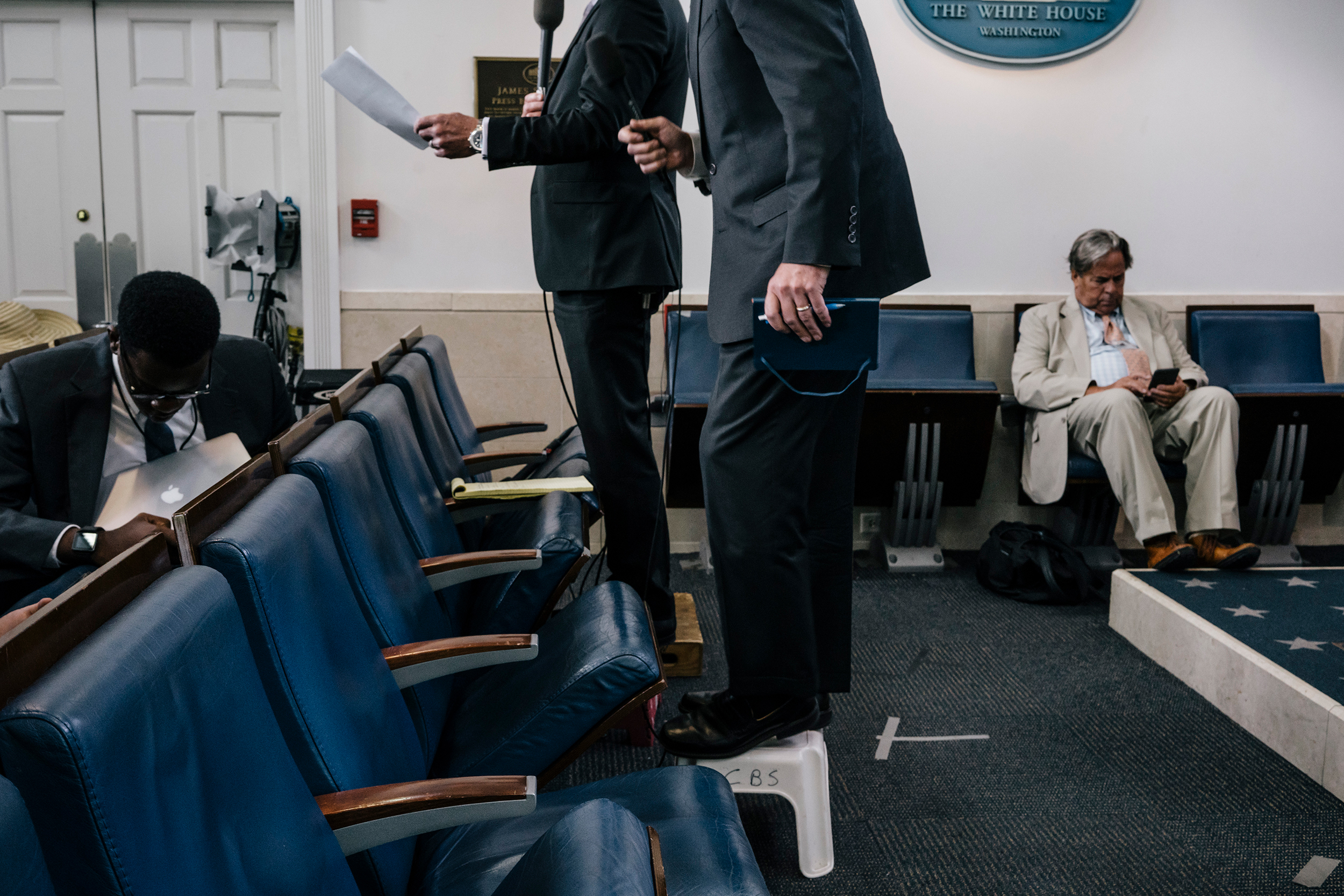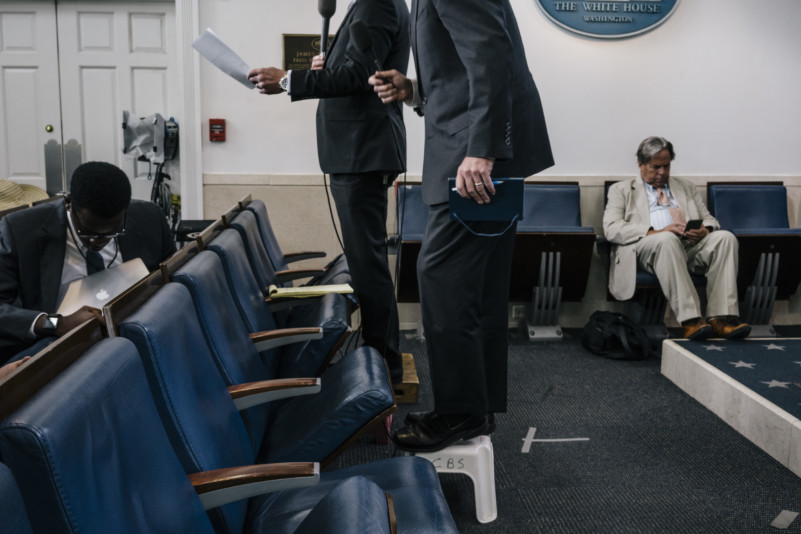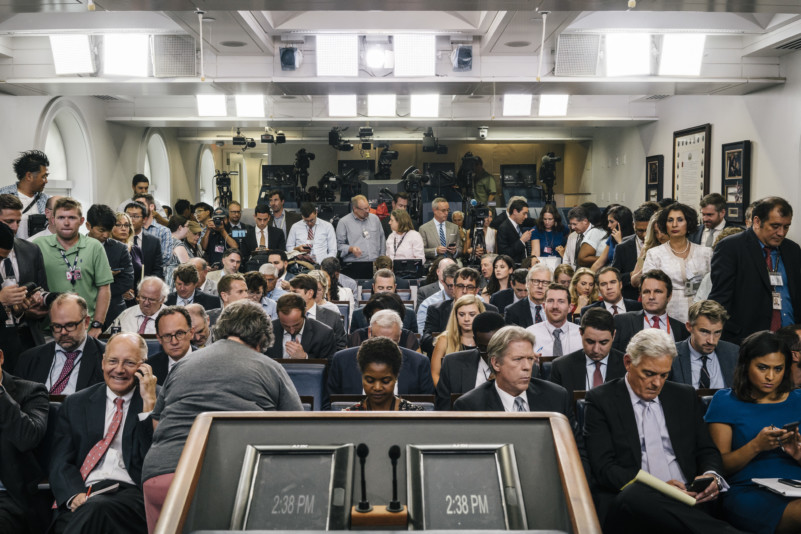When President George W. Bush approved the much-needed modernization of the James S. Brady Press Briefing Room in 2006, his administration could take satisfaction in flushing out the vermin that had infested the White House press room for years.
“Perhaps one of the most eagerly awaited parts of the renovation will be the removal of the rats that have also made the press room their home,” CBS News reported on August 2, 2006.
ICYMI: “She identified herself as a reporter. He then walked behind her and punched her”
The room, about 30 feet wide and 75 feet long, has for decades been one of Washington’s most iconic locales, partly because of its proximity to the Oval Office but also because of its role as the public forum for the presidency. In the Trump White House, the briefing room’s profile has been supercharged, as the daily briefings there have become part of a running cable-news saga.
The legacy of ‘Fatty’
The seeds of the modern press room lie in the ingenuity of one William “Fatty” Price, a reporter for the Washington Evening Star. Price is hailed as the first journalist who ever planted himself at the White House on a regular basis—outside the North Portico—starting in 1896.
The enterprising Price buttonholed the visitors who had met with President Grover Cleveland during his second term. His mission was pretty much the same as the reporters who flock today to the daily briefing: to find out what the US president said, when, and to whom.
Time, in 1941, called Price “nervy” and said he introduced “the beginning of modern White House press coverage.” Before long, Price had his own column, “At the White House.” Inevitably, he also started to have company at the front steps of 1600 Pennsylvania Avenue. Thus, the White House press corps was born.
William McKinley might well have noticed Price’s progress, too, and recognized that the media was gaining currency in national politics. During his 1896 presidential campaign, McKinley started “front-porch” meetings with reporters, casual encounters designed to show that McKinley, who sensed what friendly press relations could do for his candidacy, was one of the boys.
McKinley continued the practice until his assassination in 1901, six months into his second term, permitting journalists to report from a table in the White House. McKinley’s personal secretary introduced a tradition of holding somewhat regular briefings with reporters, which has continued to this day (though what constitutes “regular” has varied depending on the president).
McKinley’s vice president and successor, Theodore Roosevelt, followed his fallen boss’ lead and used the nascent idea of a press briefing area to put his stamp on the art of media manipulation.
Roosevelt could sense the changing rhythms of the nation in the new 20th century. He recognized that Americans were growing more interested in the pronouncements of the White House, perhaps because he had proven to be such a charismatic leader. As a result, the leading US dailies sent their best journalists to cover the executive branch.
Reporters were given a unified space in the new Executive Office Building, which has since been usurped by the expanded West Wing. The correspondents had access to the president and the use of three telephones to call in their dispatches.
In 1934, the second year of Franklin Delano Roosevelt’s first term, the West Wing was completely redesigned and the press room rebuilt. It had desks, typewriters, and telephone links to telegraph companies. Areas were set aside for correspondents to play card games and chess in between filing their stories.
From archives: Journalist who broke Trump groping story on why others were slow
The briefing room pool
The place that would physically become today’s briefing room began as a swimming pool. The pool started out as the handiwork of newspaper publisher Captain Joseph Patterson, who ran the New York Daily News and wanted to show his affection for FDR, who was stricken with polio. Since Roosevelt was physically unable to participate in sports, the publisher recognized that the president would be able to swim as a way of exercising at his own leisure.
Patterson pledged $1,000 of his own money to the project, a considerable amount during the Great Depression. In addition, he beseeched school kids to donate coins to “help build a pool for Roosevelt.” Within three months, the captain’s pet project had come to fruition.
By 1950, Harry Truman had to deal with more reporters on the beat and the increasing influence of television news. Truman decided that the White House had to move the press conferences out of the president’s office.
Out of a sense of practicality, Truman selected the Indian Treaty Room, in what is now called the Eisenhower Executive Office Building. A May 1950 Washington Post article presented an impression of the Oval Office press conferences as justification enough for the move:
The informal procedure at the conferences in the oval room of the Executive Offices, with the reporters swarming around the presidential desk, had of course certain advantages. It enabled the President to become personally acquainted with the correspondents who were covering the White House beat, it made for a certain liveliness in the character of the questions and answers, and it often elicited unexpected bits of news. But these advantages gradually vanished as the number of newspapermen, American and foreign, regularly attending the conferences began to mount into the hundreds. The oval room on conference day began to resemble a Times Square subway platform at the rush hours.
The press room in the 1960s
By the 1960s, the press room was badly in need of repair, but it would take about a decade for the White House to do anything about it. Presidents Kennedy and Lyndon Johnson, meantime, were enjoying the pool. Kennedy relaxed there to ease his chronic back pain. His image as a man of the people extended to encouraging his assistants of all ranks to join him as he exercised at lunchtime.
Johnson had an entirely different notion of the place, as Town & Country magazine noted in a January 2017 piece. Johnson’s staff “would find any credible excuse to scatter whenever LBJ expressed a desire to take a swim, for not only would he swim in and lounge around in the pool completely naked, but he would insist that others do the same. In a scene that is most unsettling to imagine, he once cajoled the preacher Billy Graham to join him in one of his skinny-dipping sessions. (They prayed together in the water.)”
The fate of the pool was sealed by President Richard Nixon, who preferred bowling to swimming. So, in 1969, the White House announced plans to build a press center over the swimming pool. The room was built at a cost of $574,000, with Nixon mandating that the architects ensure that the new room could be converted back to a pool if one of his successors so desired.
The press room faces an uncertain future under a Trump administration that has made hostility toward the media a central plank.
Given Nixon’s already frosty dealings with the national press, the joke at the time was that Nixon’s press secretary Ron Ziegler could press a secret button at the podium and the floor would suddenly fly open, like a scene in a James Bond movie, plunging the reporters into the water.
While the number of journalists who came to the White House had grown unwieldy by then, Nixon wanted to push the press corps farther away so they had less access to official visitors. “Nixon didn’t do the media any favors,” says Martha Joynt Kumar, the director of the White House Transition Project, who has written and co-written such books as Managing the President’s Message.
By 1970, work was complete on what had been the pool area and journalists began to use the West Terrace Press Center, which had been employed as a lounge and work area. It had 40 cubicles and 12 sound booths. Almost immediately, it was too small.
Ron Nessen, the press secretary for President Gerald Ford from 1974 to the end of Ford’s presidency in January 1977, recalls that reporters who didn’t stand “sat on window sills or on the floor. A few sat in folding chairs in the back of the room.”
Kumar, who attended her first White House briefing in December 1975, remembers sitting on a windowsill, before upgrading to a step-stool she bought from Home Depot.
Through the ensuing years, the pool-cum-press room was given an official name—in honor of James Brady, the press secretary to Ronald Reagan who was paralyzed when John Hinckley attempted to assassinate Reagan in 1981—but continued to steadily deteriorate. In 1997, The Washington Post, according to the Town & Country piece, said it was “among the dingiest dumps in Washington.”
The Bush renovation
On August 2, 2006, President George Bush and journalists bid a fond farewell to the deteriorating West Wing briefing room.
“We felt your pain,” Bush joked.
The revamped room had wider and taller seats and there were seven seats in each row, up from six, though one regular attendee at the daily briefing told me that the feeling of sitting there is like sitting in a coach seat on an airplane.
Now the bottom of the famed pool can hardly be seen under the tangle of television cables. The addition of loudspeakers and pick-up microphones over the seats balanced the sound and took away the need for a boom microphone. The White House also installed TV production work areas at the rear of the room to create a protected area so technicians could do their jobs while facing the front of the room, which they could not do easily in the past.
The end of the press room?
The press room faces an uncertain future under a Trump administration that has made hostility toward the media a central plank. On January 15, 2017, then-Chief of Staff Reince Priebus said on Meet the Press that the administration had pondered the idea of moving the press corps out of the White House to the Eisenhower Executive Office Building, a short walk away.
Since Trump took office, his press secretaries, first Sean Spicer and then Sarah Huckabee Sanders, have held audio-only press briefings at times, as well as private huddles that have excluded media outlets not favored by Trump.
As with so many things in Washington, the future of press briefings breaks down along partisan lines. In July, Rep. Jim Himes, a Democrat from Connecticut, proposed the “Free Press Act,” mandating that two press briefings a week must be video recorded because the Trump administration has been presenting “an overtly hostile attitude toward the press.”
Peter Baker, the chief White House correspondent for The New York Times, said it ultimately makes little difference what kind of room the White House chooses to brief reporters in.
“We’re like water on a rock,” Baker said. “If we’re blocked here, we’ll go there. We’re going to keep on coming. We’re going to do our job whether they talk to us or shut the cameras off. If the press secretary wants to be helpful, great. If not, fine.”
ICYMI: You might’ve seen the Times‘s Weinstein story. But did you miss the bombshell published days after?
Jon Friedman teaches at the Stony Brook University School of Journalism and LIU Post. He wrote the Media Web column of MarketWatch for more than 13 years, and covered Wall Street for Bloomberg News, USA Today, and Businessweek. He has written for The New York Times and The New York Post as well as the websites of The Wall Street Journal, Esquire, and Time. He has also written and co-written several nonfiction books.




